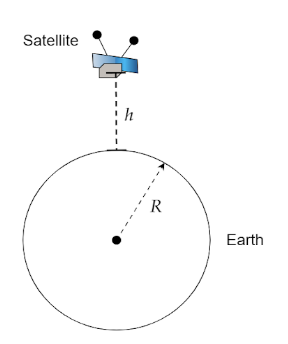
(a) At what height above Earth’s Surface is the energy required to lift a satellite to that height equal to the kinetic energy required for the satellite to be in orbit at that height.
(b) For greater heights, which is greater, the energy for lifting or the kinetic energy for orbiting.
Answer
412.5k+ views
Hint: In this question, we have to find the energy required to move a particle at a distance from the surface of the Earth. Then we have to find the kinetic energy required to raise a satellite to move in an orbit. Then according to the question, both the energies are equal. We have to just compare the equations and hence find the answer.
Complete step by step answer:

Let the height at which the satellite is kept be
Initial potential energy
where
Potential energy at height
So, the energy required to lift the satellite to height
Now, let us find the kinetic energy required to keep the satellite at that state.
The centripetal force that acts on the satellite is equal to the force of gravitation, that’s why it revolves around it.Therefore,
Multiplying
So, the kinetic energy required to keep the satellite in that position is
According to the question, the kinetic energy and potential energy are equal.
Solving the equation we get,
The radius of earth is
(b) For greater heights,
Note: It must be noted that the initial kinetic energy required to position the satellite at that height is not as equal to the energy asked in the question. Or else we would imply the conservation of total energy of a system remains conserved. The potential energy is in negative sign as it implies the direction.
Complete step by step answer:

Let the height at which the satellite is kept be
Initial potential energy
where
Potential energy at height
So, the energy required to lift the satellite to height
Now, let us find the kinetic energy required to keep the satellite at that state.
The centripetal force that acts on the satellite is equal to the force of gravitation, that’s why it revolves around it.Therefore,
Multiplying
So, the kinetic energy required to keep the satellite in that position is
According to the question, the kinetic energy and potential energy are equal.
Solving the equation we get,
The radius of earth is
(b) For greater heights,
Note: It must be noted that the initial kinetic energy required to position the satellite at that height is not as equal to the energy asked in the question. Or else we would imply the conservation of total energy of a system remains conserved. The potential energy is in negative sign as it implies the direction.
Recently Updated Pages
Master Class 9 General Knowledge: Engaging Questions & Answers for Success

Master Class 9 English: Engaging Questions & Answers for Success

Master Class 9 Science: Engaging Questions & Answers for Success

Master Class 9 Social Science: Engaging Questions & Answers for Success

Master Class 9 Maths: Engaging Questions & Answers for Success

Class 9 Question and Answer - Your Ultimate Solutions Guide

Trending doubts
State and prove Bernoullis theorem class 11 physics CBSE

What are Quantum numbers Explain the quantum number class 11 chemistry CBSE

Who built the Grand Trunk Road AChandragupta Maurya class 11 social science CBSE

1 ton equals to A 100 kg B 1000 kg C 10 kg D 10000 class 11 physics CBSE

State the laws of reflection of light

One Metric ton is equal to kg A 10000 B 1000 C 100 class 11 physics CBSE




